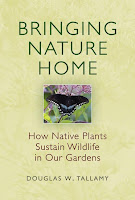Bringing Nature Home: How Native Plants Sustain Wildlife in Our Gardens by Douglas W. Tallamy

I'm a gardener, and I don't want to grow only native plants. This book makes me stop and think. Douglas Tallamy makes the best case for use of native plants I've read. I recommend it without reservation.
Tallamy writes with grace and humor. He makes it easy to follow his arguments, uses copious examples to relate his ideas to the natural world we all know, and uses down-to-earth anecdotes to illustrate his points clearly. The book, even with its many, for me, unpronounceable binomial Latin names for a multitude of insects, is an easy read. I finished it in two days, while busy with work and many other chores.
Simply put, the book's message is this. All life on earth, except for some recently discovered, relatively rare forms that take energy from volcanic vents in the ocean floor, depend on energy from the sun that plants convert into food through photosynthesis. Most of that solar energy is made available to higher life forms through insects that eat plants. With the exception of a few direct herbivores such as cows, all other higher forms of life either eat insects (most birds) or eat other animals that eat insects (hawks eating sparrows), and so on up the food chain. The productivity of an environment, literally the weight of biomass produced in a given area, is directly related to the insect population, and the variety of wildlife - number of species of birds and other wildlife - is also directly related to the numbers and varieties of insects living there.
Research now clearly shows that native insect populations cannot be sustained by most alien plants. Our insects have co-evolved with native plants over millions of years, and most have highly specific preferences for certain plants as food. As Professor and Chair of the Department of Entomology and Wildlife Ecology at the University of Delaware, Tallamy has access to research that tells a disturbing story. With increasing urbanization and suburbanization, loss of large forest and natural areas to development, and transformation of a vast portion of the continent into ecologically sterile lawn, we can look forward to mass extinctions of insects, birds, and other forms of life that could surpass the mass extinctions caused by the great meteorite impacts long ago.
Without the literally innumerable varieties of insects that constitute the first step in transfer of solar energy into life, massive losses of species will occur in the not too distant future. Many such extinctions are already under way.
Tallamy has statistics to back up his message. Native oaks, for example, support 517 lepidoptera species, willows, 456, birches, 413. In contrast, alien Clematis vitalba is a food source for 40 species of herbivores in its homeland, but only 1 in North America. Another example, Phragmites australis supports 170 species in its homeland, but only 5 species on this continent. Unfortunately, insects can't evolve to adapt to alien species in time to save our threatened populations. Evolution takes place over millions of years. Although the Norway maple has been on the North American continent for going on 300 years, and has become the predominant shade tree here, it still has not become a productive part of our native ecosystem. Instead, it is rapidly displacing native species of maple.
Lest you fear increasing insect populations will decimate your garden, Tallamy reassures his readers that balanced populations of insects and predators will keep each other in check. The key is to plant in sufficient variety to maintain a stable supply of insects as food, as well as birds and other creatures that feed on the insects.
Tallamy urges readers to do what they can to eliminate invasive alien species, to use native plants, to replace sterile lawns, which consist of two or three alien grass species that serve as a food source for little more than Japanese beetle grubs, with sustaining native plant refuges. He urges those who live in suburbia to plant native shade trees, even groves, to plant natives along lot lines to begin reestablishing productive areas where insects can successfully reproduce and thrive, and where their predators can find security and cover. If you have many insects, you'll also have many birds.
Like most people, I have an aversion to what I consider ugly, even frightening insects. I find it much easier to look at pictures of pretty butterflies than spiders and sawflies, but I learned a lot about the insect world while reading this book and looking at its pictures. And now I have enough knowledge to want to learn more, and to better understand how the natural world of my garden works.
I doubt I'll be able to entirely eliminate plants of foreign origin from my garden, but I'll try to keep a much better balance of natives to aliens (mostly natives), and practice more sustainable gardening in the future. And I'll certainly work to try to convince others to reduce lawn size and incorporate native plants into their landscapes.
The book is available through Timber Press.
For an opposing position, see my posting of October 2006 (Is planting Dahlia Bishop of Landaff an immoral act?). I'm still wrestling with with this one.
James Golden